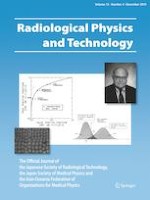Erschienen in:

06.11.2019
Evaluation of scattered radiation from fluoroscopy using small OSL dosimeters
verfasst von:
Hajime Ito, Ikuo Kobayashi, Kazutoshi Watanabe, Shigehiro Ochi, Noriyuki Yanagawa
Erschienen in:
Radiological Physics and Technology
|
Ausgabe 4/2019
Einloggen, um Zugang zu erhalten
Abstract
Recently, there has been a significant amount of interest in studying the importance of radiation doses to the eye lens during endoscopic retrograde cholangiopancreatography (ERCP). A study that focused on measuring the scattered radiation using an ionization chamber survey meter reported that a lead curtain was useful in reducing the scattered radiation. The over-couch X-ray tube system tends to deliver higher doses to the head and neck of the staff involved in the procedure than the under-couch X-ray tube position. In this study, a small optically stimulated luminescence (OSL) dosimeter called the nanoDot was used to evaluate and measure the amount of radiation; this dosimeter was developed by Landauer Ltd. and was specifically designed for point measurements. There are numerous studies that have reported the usefulness of personal OSL dosimeters other than the nanoDot to measure scattered radiation. Here, we evaluated the amount of scattered radiation, along with the degree of reduction achieved with the use of a protective curtain, while employing a personal OSL dosimeter and nanoDot. When the scattered radiation dose was measured using the nanoDot, the maximum recorded value without a protective curtain was 0.363 mGy and that with a protective curtain was 0.026 mGy, both at the height of 100 cm. The maximum reduction rate of scattered radiation while using a protective curtain was approximately 93% and 97% at 100 cm and 150 cm, respectively. The measured values recorded using both personal OSL dosimeters and nanoDot machine were strongly correlated.